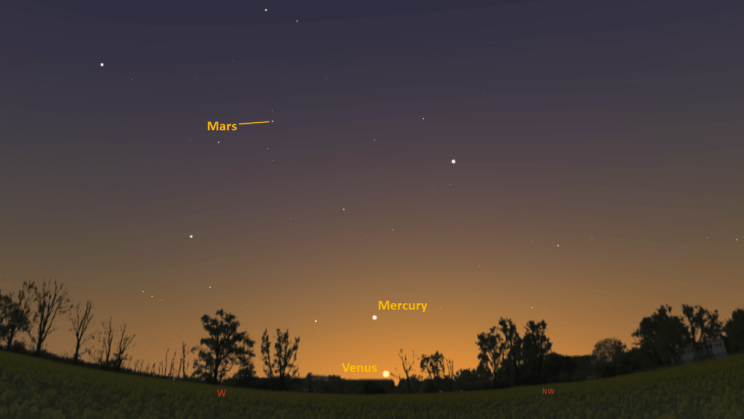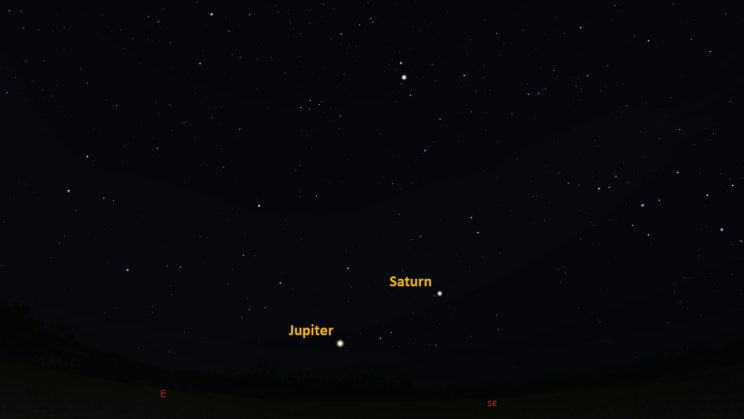This is the Saint Louis Science Center’s NIGHT SKY UPDATE for the week of Friday, May 7, 2021.
Information updated weekly or as needed.
Times given as local St. Louis time which is Central Daylight Time (CDT). For definitions of terminology used in the night sky update, click the highlighted text. If relying on times posted in Universal Time (UT), St. Louis is -5 hours when CDT.
Public Telescope Viewings
Star parties at the Saint Louis Science Center have temporarily been canceled due to recommendations from the CDC regarding COVID-19. All public telescope events are canceled until further notice. As conditions change, we will reevaluate and update this article once public observing events resume.
Observing Highlight of the Week
For those who enjoy tracking the International Space Station, you have a new space station to observe. On April 29, 2021, China launched the Tianhe-1 module, the first of three segments that will be part of China’s space station. Much Like ISS and Mir, Tianhe is a modular design, and when complete, it will be similar in size to the Mir space station. Tianhe will be able to support three astronauts; the first group is scheduled to arrive in June 2021 aboard Shenzhou 12.
There are several passes of Tianhe-1 that will be visible from St. Louis over the next few weeks. At the beginning of the week, visible passes of Tianhe-1 occur in the early morning, but later they transition to evening passes. Like most satellites, you will want to look for a bright star-like object that is moving and is not blinking. Tianhe-1 varies from roughly 1.0 to 3.5 magnitude. If viewing from light-polluted locations, you may need binoculars to spot Tianhe-1. The table below lists a few of the best passes of Tianhe-1 that will be seen from St. Louis over the next week. Information for these passes come from www.heavens-above.com.
Lastly, an astrophotographer named Phillip Smith out of Manorville, NY, was able to capture an amazing image of Tianhe-1. You can find the image posted here.
Visible passes of Tianhe-1 from St. Louis
| Date | Starts | Max. altitude | Ends | |||||||
|---|---|---|---|---|---|---|---|---|---|---|
| Time | Alt. | Az. | Time | Alt. | Az. | Time | Alt. | Az. | ||
| 09 May | 0.9 | 04:24:48 | 29 | WNW | 04:26:15 | 82 | SSW | 04:29:23 | 10 | ESE |
| 14 May | 0.9 | 21:53:28 | 10 | WSW | 21:56:31 | 78 | S | 21:56:31 | 78 | S |
| 16 May | 1.1 | 21:20:14 | 10 | WSW | 21:23:19 | 78 | NNW | 21:26:05 | 13 | ENE |
The Sun and Moon

The Moon as seen from the International Space Station, on July 31, 2011.
Credit: NASA
Sunrise is at 5:57 a.m. on Friday, May 7 and sunset is at 7:59 p.m. providing us with nearly 14 hours of daylight. Even after sunset, the light from the Sun will dimly illuminate our sky for about 1 hour and 40 minutes. This period is called twilight, which ends around 9:43 p.m. this week. For those with a sundial, local noon occurs around 12:58 p.m. this week.
| Day | Sunrise | Sunset |
|---|---|---|
| 2021-05-07 | 5:57 a.m. | 7:59 p.m. |
| 2021-05-08 | 5:56 a.m. | 8:00 p.m. |
| 2021-05-09 | 5:55 a.m. | 8:01 p.m. |
| 2021-05-10 | 5:54 a.m. | 8:02 p.m. |
| 2021-05-11 | 5:53 a.m. | 8:03 p.m. |
| 2021-05-12 | 5:52 a.m. | 8:04 p.m. |
| 2021-05-13 | 5:51 a.m. | 8:05 p.m. |
| 2021-05-14 | 5:50 a.m. | 8:06 p.m. |
| 2021-05-15 | 5:49 a.m. | 8:06 p.m. |
Moon
Tonight, moonrise occurs after midnight at 04:43 a.m. Moonset will occur at 5:12 p.m. on Saturday, May 8. On Friday, May 7, the Moon will exhibit a waning crescent phase with 7% of the lunar disk visible. New moon occurs on May 7 at 2:00 p.m.
International Space Station (ISS) Observing

Visible passes of ISS from St. Louis for the week of May 7 occur during morning and evening hours. The best passes this week occur on the mornings of May 12 and 15 and on the evenings of May 14 and 15. Use the table below for information about these and other visible passes this week.
Catch ISS from St. Louis starting Friday, May 7
| Date | Starts | Max. altitude | Ends | |||||||
|---|---|---|---|---|---|---|---|---|---|---|
| Time | Alt. | Az. | Time | Alt. | Az. | Time | Alt. | Az. | ||
| 08 May | -0.7 | 05:12:55 | 10 | NNW | 05:14:40 | 13 | NNE | 05:16:25 | 10 | NE |
| 10 May | -1.1 | 05:14:15 | 10 | NNW | 05:17:01 | 23 | NNE | 05:19:47 | 10 | E |
| 11 May | -0.7 | 04:27:05 | 10 | NNW | 04:29:24 | 17 | NNE | 04:31:42 | 10 | ENE |
| 12 May | -0.5 | 03:39:58 | 10 | NNW | 03:41:43 | 13 | NNE | 03:43:28 | 10 | NE |
| 12 May | -2.8 | 05:15:48 | 10 | NW | 05:19:08 | 54 | NE | 05:22:27 | 10 | ESE |
| 13 May | -1.9 | 04:28:30 | 10 | NW | 04:31:37 | 33 | NNE | 04:34:43 | 10 | E |
| 13 May | -2.4 | 21:11:23 | 10 | S | 21:13:24 | 20 | SSE | 21:13:24 | 20 | SSE |
| 14 May | -1.2 | 03:41:16 | 10 | NNW | 03:44:02 | 23 | NNE | 03:46:48 | 10 | E |
| 14 May | -3.5 | 05:17:43 | 10 | WNW | 05:20:59 | 46 | SW | 05:24:14 | 10 | SSE |
| 14 May | -3.4 | 21:59:46 | 10 | WSW | 22:03:06 | 66 | NW | 22:06:28 | 10 | NE |
| 14 May | -0.5 | 23:38:29 | 10 | NW | 23:40:26 | 14 | NNW | 23:42:24 | 10 | NNE |
| 15 May | -0.7 | 02:54:05 | 10 | NNW | 02:56:24 | 17 | NNE | 02:58:43 | 10 | ENE |
| 15 May | -3.9 | 04:30:12 | 10 | NW | 04:33:35 | 86 | SW | 04:36:57 | 10 | SE |
| 15 May | -3.9 | 21:12:20 | 10 | SW | 21:15:40 | 69 | SE | 21:19:00 | 10 | NE |
| 15 May | -0.9 | 22:50:18 | 10 | WNW | 22:52:46 | 19 | NNW | 22:55:15 | 10 | NNE |
Magnitude (Mag): The Measure of brightness for a celestial object. The lower the value is, the brighter the object will be.
Altitude (Alt): The angle of a celestial object measured upwards from the observer’s horizon.
Azimuth (Az): The direction of a celestial object, measured clockwise from an observer’s location with north being 0°, east being 90°, south being 180° and west being 270°.
For information about ISS flyovers and other visible satellites, visit www.heavens-above.com
Detailed information regarding all unmanned exploration of our universe, missions past, present, and planned, can be found at Jet Propulsion Laboratories:
The Visible Planets

Looking West, at 8:30 pm, May 7, 2021
Credit: Stellarium, EG,

Looking Southeast, at 3:30 am, May 08, 2021
Credit: Stellarium, EG
This week, five naked eye planets are visible. Mercury and Venus can be found in the west northwest just after sunset. Mars is found in the west after sunset. Jupiter and Saturn can be found in the southeast before sunrise.
Mercury
Mercury is starting another evening apparition. The elusive planet will remain visible in the west through most of May. Mercury will reach greatest eastern elongation on May 17. After this we will see Mercury less and less each day as it heads towards inferior conjunction on June 10, 2021. Look for Mercury in the west northwest about 30 minutes after sunset.
Venus
Venus is starting another evening apparition. It is still a little too close to the Sun to see easily see but with a clear view to the west northwest you might catch a glimpse of Venus about 20 minutes after sunset. Make sure the Sun has set before trying to find Venus this week.
Mars
Currently Mars appears as a 1.6-magnitude object that will be visible high in the west about 40 minutes after sunset. Mars sets by 12:00 a.m.
Jupiter
Jupiter is visible in the southeast before sunrise. Jupiter rises at 2:46 a.m. and will be easy to see in the southeast by 3:30 a.m.
Saturn
Saturn has returned to our morning sky. Saturn rises at 2:01 a.m. and will be easy to spot by 3:00 a.m. looking southeast.
James S. McDonnell Planetarium
Night Sky Update: May 07-May 15, 2021






